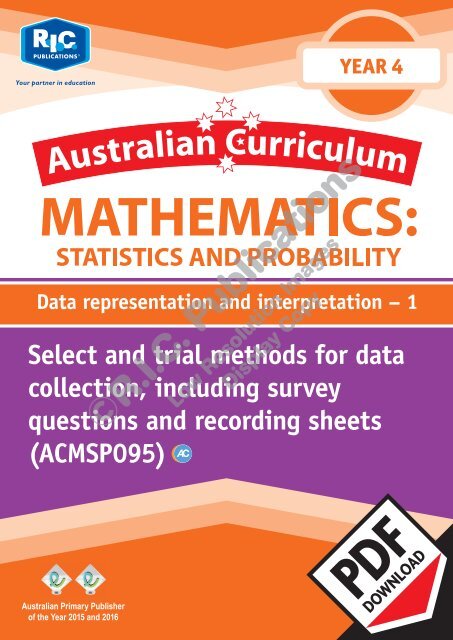RIC-20265_ACM_Statistics_and_Probability_Year_4–Data_representation_and_interpretation–1
You also want an ePaper? Increase the reach of your titles
YUMPU automatically turns print PDFs into web optimized ePapers that Google loves.
©R.I.C. Publications<br />
Low Resolution Images<br />
Display Copy
Australian Curriculum Mathematics<br />
resource book: <strong>Statistics</strong> <strong>and</strong> <strong>Probability</strong><br />
(<strong>Year</strong>s 3 & 4)<br />
Published by R.I.C. Publications ® 2014<br />
Copyright © Clare Way 2014<br />
<strong>RIC</strong>–<strong>20265</strong><br />
All material identified by is material subject to<br />
copyright under the Copyright Act 1968 (Cth) <strong>and</strong> is owned<br />
by the Australian Curriculum, Assessment <strong>and</strong> Reporting<br />
Authority 2014.<br />
For all Australian Curriculum material except<br />
elaborations: This is an extract from the Australian<br />
Curriculum.<br />
Elaborations: This may be a modified extract from the<br />
Australian Curriculum <strong>and</strong> may include the work of other<br />
authors.<br />
Disclaimer: ACARA neither endorses nor verifies the<br />
accuracy of the information provided <strong>and</strong> accepts no<br />
responsibility for incomplete or inaccurate information.<br />
In particular, ACARA does not endorse or verify that:<br />
• The content descriptions are solely for a particular year<br />
<strong>and</strong> subject;<br />
• All the content descriptions for that year <strong>and</strong> subject<br />
have been used; <strong>and</strong><br />
• The author’s material aligns with the Australian<br />
Curriculum content descriptions for the relevant year<br />
<strong>and</strong> subject.<br />
You can find the unaltered <strong>and</strong> most up to date version of<br />
this material at http://www.australiancurriculum.edu.au/<br />
This material is reproduced with the permission of ACARA.<br />
Copyright Notice<br />
A number of pages in this book are worksheets.<br />
The publisher licenses the individual teacher who<br />
purchased this book to photocopy these pages to h<strong>and</strong><br />
out to students in their own classes.<br />
Except as allowed under the Copyright Act 1968, any<br />
other use (including digital <strong>and</strong> online uses <strong>and</strong> the<br />
creation of overhead transparencies or posters) or any<br />
use by or for other people (including by or for other<br />
teachers, students or institutions) is prohibited. If you<br />
want a licence to do anything outside the scope of the<br />
BLM licence above, please contact the Publisher.<br />
This information is provided to clarify the limits of this<br />
licence <strong>and</strong> its interaction with the Copyright Act.<br />
For your added protection in the case of copyright<br />
inspection, please complete the form below. Retain this<br />
form, the complete original document <strong>and</strong> the invoice<br />
or receipt as proof of purchase.<br />
Name of Purchaser:<br />
Date of Purchase:<br />
Supplier:<br />
School Order# (if applicable):<br />
Signature of Purchaser:<br />
©R.I.C. Publications<br />
Low Resolution Images<br />
Display Copy<br />
Internet websites<br />
In some cases, websites or specific URLs may be recommended. While these are checked <strong>and</strong> rechecked at the time of publication,<br />
the publisher has no control over any subsequent changes which may be made to webpages. It is strongly recommended that the<br />
class teacher checks all URLs before allowing students to access them.<br />
View all pages online<br />
PO Box 332 Greenwood Western Australia 6924<br />
Website: www.ricpublications.com.au<br />
Email: mail@ricgroup.com.au
Australian Curriculum Mathematics<br />
resource book:<br />
<strong>Statistics</strong> <strong>and</strong> <strong>Probability</strong><br />
(<strong>Year</strong>s 3 & 4)<br />
Foreword<br />
Australian Curriculum Mathematics resource book: <strong>Statistics</strong> <strong>and</strong> <strong>Probability</strong> (<strong>Year</strong>s 3 & 4) is one in a series of three teacher resource books that<br />
support teaching <strong>and</strong> learning activities in Australian Curriculum Mathematics. The books focus on the <strong>Statistics</strong> <strong>and</strong> <strong>Probability</strong> content str<strong>and</strong>s of<br />
the Australian mathematics curriculum. The resource books include theoretical background information, resource sheets, h<strong>and</strong>s-on activities <strong>and</strong><br />
assessment activities, along with links to other curriculum areas.<br />
Titles in this series are: Australian Curriculum Mathematics resource book: <strong>Statistics</strong> & <strong>Probability</strong> (Foundation/<strong>Year</strong>s 1 & 2)<br />
Australian Curriculum Mathematics resource book: <strong>Statistics</strong> & <strong>Probability</strong> (<strong>Year</strong>s 3 & 4)<br />
Australian Curriculum Mathematics resource book: <strong>Statistics</strong> & <strong>Probability</strong> (<strong>Year</strong>s 5 & 6)<br />
Format of this book....................... iv – v<br />
<strong>Year</strong> 3<br />
Chance......................................... 2–11<br />
• Chance –1<br />
Conduct chance experiments, identify <strong>and</strong><br />
describe possible outcomes <strong>and</strong> recognise<br />
variation in results (<strong>ACM</strong>SP067)<br />
––<br />
Teacher information............................................ 2<br />
––<br />
H<strong>and</strong>s-on activities............................................. 3<br />
––<br />
Links to other curriculum areas........................... 4<br />
––<br />
Resource sheets...............................................5–7<br />
––<br />
Assessment...................................................8–10<br />
––<br />
Checklist............................................................ 11<br />
Data <strong>representation</strong> <strong>and</strong><br />
interpretation.............................12–40<br />
• DR&I –1...................................12–21<br />
Identify questions or issues for categorical<br />
variables. Identify data sources <strong>and</strong> plan<br />
methods of data collection <strong>and</strong> recording<br />
(<strong>ACM</strong>SP068)<br />
––<br />
Teacher information.......................................... 12<br />
––<br />
H<strong>and</strong>s-on activities........................................... 13<br />
––<br />
Links to other curriculum areas......................... 14<br />
––<br />
Resource sheets...........................................15–18<br />
––<br />
Assessment.................................................19–20<br />
––<br />
Checklist............................................................ 21<br />
• DR&I –2...................................22–31<br />
Collect data, organise into categories <strong>and</strong><br />
create displays using lists, tables, picture<br />
graphs <strong>and</strong> simple column graphs, with<br />
<strong>and</strong> without the use of digital technologies<br />
(<strong>ACM</strong>SP069)<br />
––<br />
Teacher information.......................................... 22<br />
––<br />
H<strong>and</strong>s-on activities........................................... 23<br />
––<br />
Links to other curriculum areas......................... 24<br />
––<br />
Resource sheets...........................................25–28<br />
––<br />
Assessment.................................................29–30<br />
––<br />
Checklist........................................................... 31<br />
Contents<br />
• DR&I –3...................................32–40<br />
Interpret <strong>and</strong> compare data displays<br />
(<strong>ACM</strong>SP070)<br />
––<br />
Teacher information.......................................... 32<br />
––<br />
H<strong>and</strong>s-on activities.....................................33–34<br />
––<br />
Links to other curriculum areas......................... 34<br />
––<br />
Resource sheets...........................................35–37<br />
––<br />
Assessment.................................................38–39<br />
––<br />
Checklist............................................................ 40<br />
Answers............................................41<br />
<strong>Year</strong> 4<br />
Chance........................................42–73<br />
• Chance –1................................42–51<br />
Describe possible everyday events <strong>and</strong> order<br />
their chances of occurring (<strong>ACM</strong>SP092)<br />
––<br />
Teacher information.......................................... 42<br />
––<br />
H<strong>and</strong>s-on activities........................................... 43<br />
––<br />
Links to other curriculum areas......................... 44<br />
––<br />
Resource sheets...........................................45–48<br />
––<br />
Assessment.................................................49–50<br />
––<br />
Checklist............................................................ 51<br />
• Chance –2................................52–61<br />
Identify everyday events where one cannot<br />
happen if the other happens (<strong>ACM</strong>SP093)<br />
––<br />
Teacher information.......................................... 52<br />
––<br />
H<strong>and</strong>s-on activities........................................... 53<br />
––<br />
Links to other curriculum areas......................... 54<br />
––<br />
Resource sheets............................................55-58<br />
––<br />
Assessment.................................................59–60<br />
––<br />
Checklist............................................................ 61<br />
• Chance –3................................62–73<br />
Identify events where the chance of one will<br />
not be affected by the occurrence of the other<br />
(<strong>ACM</strong>SP094)<br />
––<br />
Teacher information.......................................... 62<br />
––<br />
H<strong>and</strong>s-on activities........................................... 63<br />
––<br />
Links to other curriculum areas......................... 64<br />
––<br />
Resource sheets...........................................65–70<br />
––<br />
Assessment.................................................71–72<br />
––<br />
Checklist............................................................ 73<br />
Data <strong>representation</strong> <strong>and</strong><br />
interpretation........................... 74–106<br />
• DR&I –1...................................74–83<br />
Select <strong>and</strong> trial methods for data collection,<br />
including survey questions <strong>and</strong> recording<br />
sheets (<strong>ACM</strong>SP095)<br />
––<br />
Teacher information.......................................... 74<br />
––<br />
H<strong>and</strong>s-on activities........................................... 75<br />
––<br />
Links to other curriculum areas......................... 76<br />
––<br />
Resource sheets...........................................77–80<br />
––<br />
Assessment.................................................81–82<br />
––<br />
Checklist............................................................ 83<br />
• DR&I –2...................................84–93<br />
Construct suitable data displays, with <strong>and</strong><br />
without the use of digital technologies,<br />
from given or collected data. Include tables,<br />
column graphs <strong>and</strong> picture graphs where<br />
one picture can represent many data values<br />
(<strong>ACM</strong>SP096)<br />
––<br />
Teacher information.......................................... 84<br />
––<br />
H<strong>and</strong>s-on activities.....................................85–86<br />
––<br />
Links to other curriculum areas......................... 86<br />
––<br />
Resource sheets...........................................87–90<br />
––<br />
Assessment.................................................91–92<br />
––<br />
Checklist............................................................ 93<br />
• DR&I –3................................. 94–106<br />
Evaluate the effectiveness of different<br />
displays in illustrating data features including<br />
variability (<strong>ACM</strong>SP097)<br />
––<br />
Teacher information.......................................... 94<br />
––<br />
H<strong>and</strong>s-on activities.....................................95–96<br />
––<br />
Links to other curriculum areas......................... 96<br />
––<br />
Resource sheets.........................................97–102<br />
––<br />
Assessment.............................................103–105<br />
––<br />
Checklist.......................................................... 106<br />
©R.I.C. Publications<br />
Low Resolution Images<br />
Display Copy<br />
Answers..........................................107<br />
Australian Curriculum Mathematics resource book: <strong>Statistics</strong> <strong>and</strong> <strong>Probability</strong> (<strong>Year</strong>s 3 & 4) R.I.C. Publications ® www.ricpublications.com.au iii
Format of this Book<br />
This teacher resource book includes supporting materials for teaching <strong>and</strong> learning in all sections of the <strong>Statistics</strong> <strong>and</strong> <strong>Probability</strong> content str<strong>and</strong> of<br />
Australian Curriculum Mathematics. It includes activities relating to sub-str<strong>and</strong>s: Chance <strong>and</strong> Data <strong>representation</strong> <strong>and</strong> interpretation. All content<br />
descriptions have been included, as well as teaching points based on the Curriculum’s elaborations. Links to the proficiency str<strong>and</strong>s have also been<br />
included.<br />
Each section supports a specific content description <strong>and</strong> follows a consistent format, containing the following information over several pages:<br />
• teacher information with related terms, student vocabulary, what the content description means, teaching points <strong>and</strong> problems to watch for<br />
• h<strong>and</strong>s-on activities<br />
• links to other curriculum areas<br />
• resource sheets<br />
• assessment sheets.<br />
• a checklist<br />
Answers relating to the resource <strong>and</strong> assessment pages are included.<br />
The length of each content description section varies.<br />
Related terms includes vocabulary associated<br />
with the content description. Many of these<br />
relate to the glossary in the back of the official<br />
Australian Curriculum Mathematics document;<br />
additional related terms may also have been<br />
added.<br />
Student vocabulary includes words which<br />
the teacher would use—<strong>and</strong> expect the<br />
students to learn, underst<strong>and</strong> <strong>and</strong> use—during<br />
mathematics lessons.<br />
The proficiency str<strong>and</strong>(s) (Underst<strong>and</strong>ing,<br />
Fluency, Problem Solving solving or Reasoning) relevant<br />
to each content description are listed. shown in bold.<br />
Teacher information includes background information relating to the content description, as well as<br />
related terms, desirable student vocabulary <strong>and</strong> other useful details which may assist the teacher.<br />
What this means provides<br />
a general explanation of the<br />
content description.<br />
Teaching points provides<br />
a list of the main teaching<br />
points relating to the content<br />
description.<br />
What to watch look for for suggests any any<br />
difficulties <strong>and</strong> misconceptions<br />
the students might encounter or<br />
develop.<br />
©R.I.C. Publications<br />
Low Resolution Images<br />
Display Copy<br />
H<strong>and</strong>s-on activities includes descriptions or<br />
instructions for games or activities relating to the<br />
content descriptions or elaborations. Some of the<br />
h<strong>and</strong>s-on activities are supported by resource<br />
sheets. Where applicable, these will be stated for<br />
easy reference.<br />
iv Australian Curriculum Mathematics resource book: <strong>Statistics</strong> <strong>and</strong> <strong>Probability</strong> (<strong>Year</strong>s 3 & 4) R.I.C. Publications ® www.ricpublications.com.au
Format of this Book<br />
Links to other curriculum areas includes activities in other curriculum areas which support<br />
the content description. These are English, Information <strong>and</strong> Communication Technology, Health<br />
<strong>and</strong> Physical Education, Science, Economics <strong>and</strong> the Arts). This section may list many links or only<br />
a few. It may also provide links to relevant interactive websites appropriate for the age group.<br />
Cross-curricular links reinforce the knowledge that mathematics can be found within, <strong>and</strong> relate<br />
to, many other aspects of student learning <strong>and</strong> everyday life.<br />
Resource sheets are provided to support<br />
teaching <strong>and</strong> learning activities for each<br />
content description. The resource sheets<br />
could be cards for games, charts, additional<br />
worksheets for class use or other materials<br />
which the teacher might find useful to use or<br />
display in the classroom. For each resource<br />
sheet, the content description to which it<br />
relates is given.<br />
Assessment pages are included. These<br />
support activities included in the h<strong>and</strong>s-on<br />
activities or resource sheets.<br />
©R.I.C. Publications<br />
Low Resolution Images<br />
Display Copy<br />
Each section has a checklist which teachers<br />
may find useful as a place to keep a record of<br />
the results of assessment activities, or their<br />
observations of h<strong>and</strong>s-on activities.<br />
Answers for resource pages (where<br />
appropriate) <strong>and</strong> assessment pages are<br />
provided.<br />
Australian Curriculum Mathematics resource book: <strong>Statistics</strong> <strong>and</strong> <strong>Probability</strong> (<strong>Year</strong>s 3 & 4) R.I.C. Publications ® www.ricpublications.com.au v
<strong>Year</strong> 4—Sub-str<strong>and</strong>: Data <strong>representation</strong> <strong>and</strong> interpretation—DR&I – 1<br />
Select <strong>and</strong> trial methods for data collection, including survey questions <strong>and</strong> recording sheets<br />
(<strong>ACM</strong>SP095)<br />
Related Terms<br />
Teacher Information<br />
Data<br />
• A term used to describe a collection<br />
of numbers or information.<br />
Survey<br />
• To collect sample opinions or facts<br />
from a group.<br />
Table<br />
• A means of organising data in rows<br />
<strong>and</strong> columns.<br />
Tally marks<br />
• Marks made to record items or<br />
events, usually grouped in fives by a<br />
diagonal line (e.g. ).<br />
Venn diagram<br />
• A diagram that represents sets <strong>and</strong><br />
their relationships. The overlapping<br />
sections of the circles represent<br />
more than one choice.<br />
What this means<br />
• Students will be presented with a variety of methods they can<br />
use to survey <strong>and</strong> collect data. They will be given the opportunity<br />
to use different methods of recording data <strong>and</strong> evaluate how<br />
effective each one is. They will come to realise that when collecting<br />
data you need to decide what sort of information to collect, where<br />
<strong>and</strong> who to collect it from <strong>and</strong> how they will need to collect it.<br />
While some methods of collection suit some investigations, other<br />
surveys or data collection may require a different method. Through<br />
this learning process students will start to choose the most<br />
effective way to collect data according to the type of investigation<br />
they are doing.<br />
Teaching points<br />
• Demonstrate the importance of correct questioning when carrying<br />
out a survey.<br />
• Present students with a variety of methods for recording <strong>and</strong><br />
collecting data.<br />
• Encourage students to recognise that the type of data collection<br />
used depends on the type of survey or investigation.<br />
• Give students the opportunity to trial various data collection<br />
methods.<br />
• Allow students the opportunity to assess <strong>and</strong> evaluate the<br />
effectiveness of their data gathering.<br />
What to look for<br />
• Students who have difficulty choosing the most effective method<br />
to collect data for an investigation.<br />
• Students who have difficulty evaluating the effectiveness of data<br />
collection methods.<br />
©R.I.C. Publications<br />
Low Resolution Images<br />
Display Copy<br />
Student vocabulary<br />
questions<br />
data<br />
collect<br />
survey<br />
tables<br />
Proficiency str<strong>and</strong>(s):<br />
Underst<strong>and</strong>ing<br />
Fluency<br />
Problem solving<br />
Reasoning<br />
74 Australian Curriculum Mathematics resource book: <strong>Statistics</strong> <strong>and</strong> <strong>Probability</strong> (<strong>Year</strong>s 3 & 4) R.I.C. Publications ® www.ricpublications.com.au
<strong>Year</strong> 4—Sub-str<strong>and</strong>: Data <strong>representation</strong> <strong>and</strong> interpretation—DR&I – 1<br />
Survey topics (pg 77)<br />
H<strong>and</strong>s–on Activities<br />
• Present students with a list of possible topics that could be used in an investigation or survey.<br />
• Use the topics to initiate a discussion about necessary questions <strong>and</strong> how investigations can be carried out.<br />
• Ask pairs of students to choose a topic from the list (or their own topic) <strong>and</strong> to come up with a question <strong>and</strong> suggest a<br />
method for how they would go about finding out this information.<br />
Methods for collecting data<br />
• Brainstorm <strong>and</strong> list all the methods there are for collecting data. For example: a list, a table that uses tally marks, a table<br />
that uses ticks, a two-way table, a survey of questions, a Venn diagram, a number line.<br />
• Suggest examples of investigations you could carry out that would use each of the methods the students have<br />
suggested. For example: draw up a number line <strong>and</strong> write on one end the word ‘never’, the other end, ‘always’ <strong>and</strong> the<br />
word ‘sometimes’ in the middle. Ask students a question such as ‘Do you go to the beach on the weekend?’ Ask those<br />
students who never do to raise their h<strong>and</strong> then use ticks, dots or any mark to show these students above the word<br />
never. Then repeat the same method for ‘sometimes’ <strong>and</strong> ‘always’.<br />
Tables for data collection (pg 78)<br />
• Give each student a copy of the sample tables that can be used to collect data. What type of investigation could these<br />
tables be used for?<br />
• Ask students to write a question to find out what electronic equipment their classmates like to use the most. Which<br />
table would be best to use in this investigation? Ask students to choose one to use when surveying their classmates.<br />
• Once completed, ask students to compare methods of data collection. Which do they think was the best or easiest to<br />
use <strong>and</strong> read?<br />
Two-way tables (pg 79)<br />
• Two-way tables are a good method to show different opinions in a survey. For example, you could ask the question, ‘Do<br />
you like fruit, vegetables or both?’ <strong>and</strong> present this information in a two-way table. Look at the example of likes/dislikes<br />
fruit <strong>and</strong> likes/dislikes vegetables. Ask students questions about the table. Is the information clear?<br />
• Use the blank two-way table to survey 10 of your classmates if they like Xbox , PlayStation or both. Look at the results.<br />
Is this an effective way to present the information? Is there another way?<br />
Venn diagram (pg 80)<br />
• A Venn diagram can represent sets of information <strong>and</strong> relationships between<br />
these sets. The overlapping sections of the circles represent more than one<br />
choice. They are useful for showing information where those surveyed can<br />
choose more than one category.<br />
• Ask the class to raise their h<strong>and</strong> if they like Xbox , PlayStation , Wii , two of<br />
these or all three. Show their responses with a ✗ on a large Venn diagram.<br />
• Give the students a Venn diagram <strong>and</strong> ask them to survey 10 of their<br />
classmates to see if they like action movies, comedy movies or scary movies.<br />
Make a plan<br />
• Model to students how to make a plan for collecting data. For example, if you<br />
wanted to find out if you classmates prefer a party at home or at a venue, you<br />
would follow these steps:<br />
––<br />
Write a survey question.<br />
––<br />
Draw up a Venn diagram <strong>and</strong> survey your classmates as to their favourite type of party.<br />
––<br />
Ask each student in your class the survey question <strong>and</strong> record their response with a ✗ on the Venn diagram.<br />
––<br />
Total up the responses on the diagram.<br />
––<br />
Write one or two statements about the results.<br />
©R.I.C. Publications<br />
Low Resolution Images<br />
Display Copy<br />
• Ask students to choose a topic <strong>and</strong> write a plan on how they are going to investigate it.<br />
Xbox<br />
Wii<br />
PlayStation<br />
Australian Curriculum Mathematics resource book: <strong>Statistics</strong> <strong>and</strong> <strong>Probability</strong> (<strong>Year</strong>s 3 & 4) R.I.C. Publications ® www.ricpublications.com.au 75
<strong>Year</strong> 4—Sub-str<strong>and</strong>: Data <strong>representation</strong> <strong>and</strong> interpretation—DR&I – 1<br />
Links to Other Curriculum Areas<br />
English<br />
• Writing: In small groups brainstorm <strong>and</strong> make a list of students likes <strong>and</strong> dislikes. Discuss how these words are<br />
considered opposites e.g. if you were to say you like quiet music you may dislike loud music.<br />
• Writing: Create your own book of questions. They could be questions about life, questions you could use in a survey,<br />
questions you might use in an interview etc.<br />
• Spelling: Make a list of words that are opposite. For example: night—day, light—dark, heavy—light, tall—short.<br />
Information <strong>and</strong> Communication Technology<br />
• Demonstrate to students how to draw up a table in a word document. Tables are useful tools for collecting <strong>and</strong><br />
recording information. Before you create a table you need to work out how many rows <strong>and</strong> columns you need<br />
according to the number of categories you have in your survey.<br />
• Go to the website , click ‘Data’ then find ‘How to do a survey‘ <strong>and</strong> ‘Survey questions’. Read<br />
through both of these <strong>and</strong> compare their methods to what you know <strong>and</strong> have learnt.<br />
Science<br />
• Tables <strong>and</strong> diagrams are often used by scientists to show investigated information. For example: Investigate mini-beasts<br />
on the internet or use a resource book <strong>and</strong> then use a table such as the one below to show how many legs a variety of<br />
mini-beasts have.<br />
lizard<br />
beetle<br />
ant<br />
spider<br />
slater<br />
centipede<br />
f ly<br />
2 legs 4 legs 6 legs 8 legs<br />
• Use a Venn diagram to make a list of items in the classroom that are recyclable or non-recyclable.<br />
10 or<br />
more legs<br />
©R.I.C. Publications<br />
Low Resolution Images<br />
Display Copy<br />
76 Australian Curriculum Mathematics resource book: <strong>Statistics</strong> <strong>and</strong> <strong>Probability</strong> (<strong>Year</strong>s 3 & 4) R.I.C. Publications ® www.ricpublications.com.au
<strong>Year</strong> 4—Sub-str<strong>and</strong>: Data <strong>representation</strong> <strong>and</strong> interpretation—DR&I – 1<br />
Resource Sheet<br />
Survey topics<br />
Copy <strong>and</strong> distribute.<br />
Birthday months<br />
Favourite takeaway food<br />
CONTENT DESCRIPTION: Select <strong>and</strong> trial methods for data collection, including survey questions <strong>and</strong> recording sheets (<strong>ACM</strong>SP095)<br />
Favourite sport<br />
Favourite subject<br />
Favourite pastime activity<br />
Favourite electronic device<br />
Number of people in<br />
the family<br />
Class pets<br />
Holiday destinations<br />
Favourite outings<br />
Party venues<br />
Favourite colour<br />
Hair colour<br />
Eye colour<br />
Favourite fruit<br />
Favourite vegetable<br />
Favourite drink<br />
Travelling to school<br />
methods<br />
Bedtimes<br />
Dinnertimes<br />
Favourite reading material<br />
©R.I.C. Publications<br />
Low Resolution Images<br />
Display Copy<br />
Favourite movies<br />
Favourite TV shows<br />
First name initial<br />
Favourite footwear<br />
Favourite musical artist<br />
Australian Curriculum Mathematics resource book: <strong>Statistics</strong> <strong>and</strong> <strong>Probability</strong> (<strong>Year</strong>s 3 & 4) R.I.C. Publications ® www.ricpublications.com.au 77
<strong>Year</strong> 4—Sub-str<strong>and</strong>: Data <strong>representation</strong> <strong>and</strong> interpretation—DR&I – 1<br />
Resource Sheet<br />
Tables for data collection<br />
Copy <strong>and</strong> distribute.<br />
©R.I.C. Publications<br />
Low Resolution Images<br />
Display Copy<br />
CONTENT DESCRIPTION: Select <strong>and</strong> trial methods for data collection, including survey questions <strong>and</strong> recording sheets (<strong>ACM</strong>SP095)<br />
78 Australian Curriculum Mathematics resource book: <strong>Statistics</strong> <strong>and</strong> <strong>Probability</strong> (<strong>Year</strong>s 3 & 4) R.I.C. Publications ® www.ricpublications.com.au
<strong>Year</strong> 4—Sub-str<strong>and</strong>: Data <strong>representation</strong> <strong>and</strong> interpretation—DR&I – 1<br />
Resource Sheet<br />
Two-way tables<br />
Copy <strong>and</strong> distribute.<br />
Likes fruit Dislikes fruit Likes vegetables<br />
Dislikes<br />
vegetables<br />
CONTENT DESCRIPTION: Select <strong>and</strong> trial methods for data collection, including survey questions <strong>and</strong> recording sheets (<strong>ACM</strong>SP095)<br />
Harry Caleb Harry Georgia<br />
Georgia Scout Caleb Lexia<br />
Lexia Sophie Matt<br />
Sophie Alex Scout<br />
Matt<br />
Alex<br />
Leila<br />
Yong<br />
Leila<br />
Yong<br />
Likes Xbox Dislikes Xbox Likes PlayStation Dislikes<br />
PlayStation <br />
©R.I.C. Publications<br />
Low Resolution Images<br />
Display Copy<br />
Australian Curriculum Mathematics resource book: <strong>Statistics</strong> <strong>and</strong> <strong>Probability</strong> (<strong>Year</strong>s 3 & 4) R.I.C. Publications ® www.ricpublications.com.au 79
<strong>Year</strong> 4—Sub-str<strong>and</strong>: Data <strong>representation</strong> <strong>and</strong> interpretation—DR&I – 1<br />
Resource Sheet<br />
Venn diagram<br />
Copy <strong>and</strong> distribute.<br />
Action<br />
movie<br />
Scary<br />
movie<br />
Comedy<br />
movie<br />
©R.I.C. Publications<br />
Low Resolution Images<br />
Display Copy<br />
CONTENT DESCRIPTION: Select <strong>and</strong> trial methods for data collection, including survey questions <strong>and</strong> recording sheets (<strong>ACM</strong>SP095)<br />
80 Australian Curriculum Mathematics resource book: <strong>Statistics</strong> <strong>and</strong> <strong>Probability</strong> (<strong>Year</strong>s 3 & 4) R.I.C. Publications ® www.ricpublications.com.au
<strong>Year</strong> 4—Sub-str<strong>and</strong>: Data <strong>representation</strong> <strong>and</strong> interpretation—DR&I – 1 Assessment 1<br />
Name:<br />
date:<br />
1. If you wanted to survey your class to find out which day their birthday fell on<br />
this year, what question would you need to ask?<br />
?<br />
2. Ask at least 10 of your classmates your question <strong>and</strong> record their responses on<br />
the table below you think works best for this survey.<br />
CONTENT DESCRIPTION: Select <strong>and</strong> trial methods for data collection, including survey questions <strong>and</strong> recording sheets (<strong>ACM</strong>SP095)<br />
Sunday<br />
Names S M Tu W Th F Sa<br />
Monday<br />
Tuesday<br />
Wednesday<br />
Thursday<br />
Friday<br />
Saturday<br />
3. Look at your information <strong>and</strong> answer the following questions:<br />
(a)<br />
(b)<br />
©R.I.C. Publications<br />
Low Resolution Images<br />
Display Copy<br />
Which day did the most birthdays fall on?<br />
Which day did the least birthdays fall on?<br />
(c) Do you think the table you chose was the best method? Yes No<br />
Why/why not?<br />
4. Could you use a Venn diagram for this survey? Yes No<br />
Why/why not?<br />
Australian Curriculum Mathematics resource book: <strong>Statistics</strong> <strong>and</strong> <strong>Probability</strong> (<strong>Year</strong>s 3 & 4) R.I.C. Publications ® www.ricpublications.com.au 81
Assessment 2 <strong>Year</strong> 4—Sub-str<strong>and</strong>: Data <strong>representation</strong> <strong>and</strong> interpretation—DR&I – 1<br />
Name:<br />
date:<br />
1. 10 students were surveyed on whether they liked reading <strong>and</strong> writing. Transfer<br />
their responses onto the two-way table below.<br />
Ashley – I like reading <strong>and</strong> writing. Ben – I like reading but don’t like writing.<br />
Jay – I don’t like reading or writing. Mia – I like reading <strong>and</strong> writing<br />
Samuel – I like both<br />
Sky – I only like writing<br />
Eden – I like reading but not writing. Josh – I like both<br />
Faith – I only like reading<br />
Manuel – I like reading <strong>and</strong> writing<br />
Likes reading Dislikes reading Likes writing Dislikes writing<br />
2. Now represent this information on the Venn diagram using crosses (✗).<br />
Likes<br />
reading<br />
3. Does the Venn diagram give us all the information?<br />
4. Which method shows the survey information the best?<br />
Why?<br />
Likes<br />
writing<br />
©R.I.C. Publications<br />
Low Resolution Images<br />
Display Copy<br />
CONTENT DESCRIPTION: Select <strong>and</strong> trial methods for data collection, including survey questions <strong>and</strong> recording sheets (<strong>ACM</strong>SP095)<br />
82 Australian Curriculum Mathematics resource book: <strong>Statistics</strong> <strong>and</strong> <strong>Probability</strong> (<strong>Year</strong>s 3 & 4) R.I.C. Publications ® www.ricpublications.com.au
<strong>Year</strong> 4—Sub-str<strong>and</strong>: Data <strong>representation</strong> <strong>and</strong> interpretation—DR&I – 1<br />
Checklist<br />
Select <strong>and</strong> trial methods for data collection, including survey questions <strong>and</strong> recording sheets<br />
(<strong>ACM</strong>SP095)<br />
Student Name<br />
Selects topics <strong>and</strong> writes<br />
appropriate questions for<br />
data collection<br />
Chooses the most<br />
effective method to<br />
collect data<br />
Compares the<br />
effectiveness of different<br />
methods of collecting<br />
data<br />
©R.I.C. Publications<br />
Low Resolution Images<br />
Display Copy<br />
Australian Curriculum Mathematics resource book: <strong>Statistics</strong> <strong>and</strong> <strong>Probability</strong> (<strong>Year</strong>s 3 & 4) R.I.C. Publications ® www.ricpublications.com.au 83
<strong>Year</strong> 4<br />
DR&I – 1<br />
<strong>Year</strong> 4 Answers<br />
Page 81 Assessment 1<br />
1. What day does your birthday fall on this year?<br />
4. No—too many categories<br />
Page 82 Assessment 2<br />
1.<br />
2.<br />
Likes reading<br />
Ashley<br />
Samuel<br />
Eden<br />
Faith<br />
Ben<br />
Mia<br />
Josh<br />
Manuel<br />
Likes writing<br />
Ashley<br />
Samuel<br />
Mia<br />
Sky<br />
Josh<br />
Manuel<br />
Dislikes reading<br />
Jay<br />
Sky<br />
Dislikes writing<br />
Jay<br />
Eden<br />
Faith<br />
Ben<br />
3. No, as it doesn’t tell us who dislikes reading <strong>and</strong> writing.<br />
4. Two-way table<br />
©R.I.C. Publications<br />
Low Resolution Images<br />
Display Copy<br />
Australian Curriculum Mathematics resource book: <strong>Statistics</strong> <strong>and</strong> <strong>Probability</strong> (<strong>Year</strong>s 3 & 4) R.I.C. Publications ® www.ricpublications.com.au 107


















